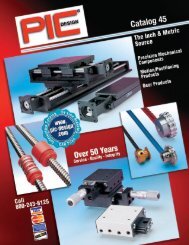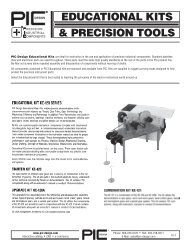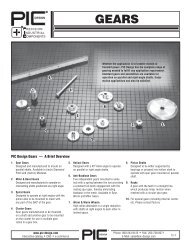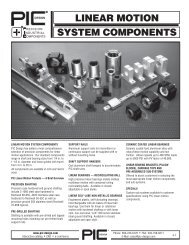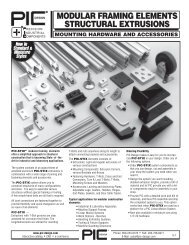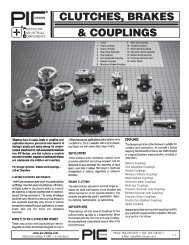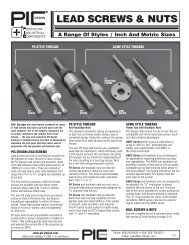PIC Design - RBC Bearings
PIC Design - RBC Bearings
PIC Design - RBC Bearings
- No tags were found...
Create successful ePaper yourself
Turn your PDF publications into a flip-book with our unique Google optimized e-Paper software.
TECHNICAL SECTIONAxial Take-Up MechanismsTY<strong>PIC</strong>AL SOLUTIONS —Backlash Compensation Without High Drag TorqueThe standard method for takingup backlash is to bias two nuthalves axially using some typeof compliant spring. (Wavywasher, compression spring,rubber washer, etc.)The unit is very stiff in the direction in which the nut half is loadedagainst the flank of the screw thread. However, in the direction awayfrom the screw thread, the nutis only as axially stiff as theamount of preload which thespring exerts.For example, if the maximumaxial load which the system issubjected to is 50 lbs., the amount of spring preload must be equal toor greater than 50 lbs. in order to maintain intimate screw/nut contact.The problems arising from preloading in this manner are increasedtorque and nut wear.An alternate method would thus be to replace the spring with a stiffspacer sized to fit exactly between the two nut halves.There would then be noexcessive preload force at theinterface and the unit wouldbe capable of carrying highaxial loads in either directionwith no backlash.This is fine initially. However, asuse time increases, wear beginson the nut threads causing a gapto develop between the spacer(L) and the nut halves.This gap (Δ1 +Δ 2) is now theamount of backlash which has developed in the unit. This backlash can beremoved by replacing the stiff spacer with a new spacer equal to(L + Δ1 +Δ 2). This process, although effective, would be extremelycostly and difficult to implement on a continuous basis.A PATENTED SOLUTIONWhat is needed, then, is a stiff spacer which will continually expand toaccommodate the wear which occurs during use.This is done by creating a spacer threaded at one end with a complimentarynut torsionally biased to advance when a gap develops.The thread at the end of the spacer is a fine helix such that an axial loadwill not backdrive the nut oncespacer growth has occurred.The amount of preload on theunit is only that necessary toturn the spacer nut on thespacer rod and is independentof the external systemloadings. THIS PATENTEDDESIGN HAS A SELF-WEAR COMPENSATING UNIT WHICH HAS EX-TREMELY LOW FRICTIONAL DRAG TORQUE YET HIGH AXIAL STIFF-NESS.JOURNAL/END MACHINING & MOUNTING ACCESORIESFor Use With Series S10 and S12 BlocksUNDERCUT - .04 Max Width.015 Max DepthD +.0000-.0003 D +.000-.001End MachiningAvailable at an additional cost. <strong>PIC</strong> offers a typical journal for use with abearing/ mount support. Custom end machining available. Send drawingwith your RFQ.— Please Note:— Bearing Shaft Spacers are listed in Catalog Section 6— Couplings are listed in Catalog Section 7— Linear <strong>Bearings</strong> and Shafting are listed in Catalog Section 4LDThe data presented below will be useful when designing lead screw systemsusing Series S10 Universal Bearing Blocks and Series S12 Bearing Blocks.When Using Series S10 Universal Bearing BlocksScrewDia.DJournalDia.LJournalLengthBall Retaining Shim ShaftBearing Ring Pack Collar3/16 0.1247 1.00 E1-3 Z1-1 SP-06 C1-11 /4 0.1247 1.00 E1-3 Z1-1 SP-06 C1-15 /16 0.1872 1.12 E1-8 Z1-2 SP-08 C1-23 /8 0.2497 1.12 E1-9 Z1-3 SP-10 C1-37 /16 0.2497 1.12 E1-9 Z1-3 SP-10 C1-31/2 0.3747 1.38 E1-15 Z1-5 SP-14 C1-105/8 0.3747 1.38 E1-15 Z1-5 SP-14 C1-10When Using Series S12 Bearing BlocksD L FlangedScrewFlange FlangeJournal JournalBall BearingDia.Adaptor SpacerDia. LengthBearing Housing3 /16 0.1247 0.6 LMB-4 E2-3 S12-41 /4 0.1247 0.6 LMB-4 E2-3 S12-45 /16 0.1872 0.75 LMB-6 E2-6 S12-53/8 0.2497 0.813 LMB-6 E2-9 S12-87/16 0.2497 0.813 LMB-8 E2-9 S12-81/2 0.2497 0.813 LMB-8 SMB-8 E2-9 S12-85 /8 0.3747 1.083 LMB-10 SMB-10 E2-15 S12-103-4Phone: 800-243-6125 ■ FAX: 203-758-8271E-Mail: sales@pic-design.comDESIGN®www.pic-design.comInteractive catalog ■ CAD ■ e-commerce




